Seat Exeo 2009 Owner's manual
Manufacturer: SEAT, Model Year: 2009, Model line: Exeo, Model: Seat Exeo 2009Pages: 310, PDF Size: 8.54 MB
Page 121 of 310
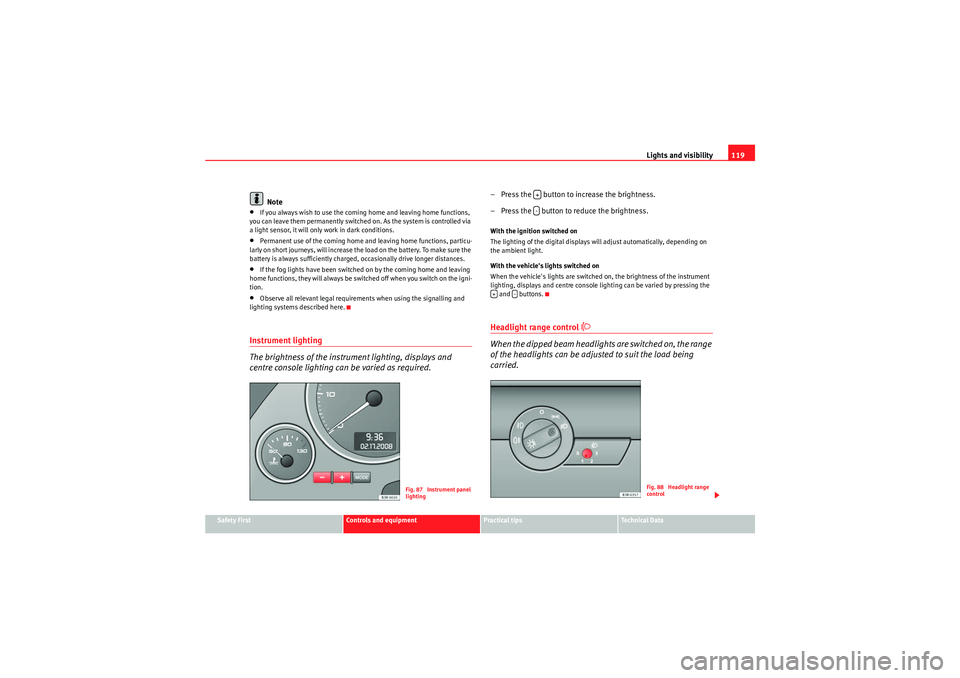
Lights and visibility119
Safety First
Controls and equipment
Practical tips
Technical Data
Note
•If you always wish to use the coming home and leaving home functions,
you can leave them permanently switched on. As the system is controlled via
a light sensor, it will only work in dark conditions.•Permanent use of the coming home and leaving home functions, particu-
larly on short journeys, will increase the load on the battery. To make sure the
battery is always sufficiently charged, occasionally drive longer distances.•If the fog lights have been switched on by the coming home and leaving
home functions, they will always be switched off when you switch on the igni-
tion.•Observe all relevant legal requirements when using the signalling and
lighting systems described here.Instrument lighting
The brightness of the instrument lighting, displays and
centre console lighting can be varied as required.
– Press the button to increase the brightness.
– Press the button to reduce the brightness.With the ignition switched on
The lighting of the digital displays will adjust automatically, depending on
the ambient light.
With the vehicle's lights switched on
When the vehicle's lights are switched on, the brightness of the instrument
lighting, displays and centre console lighting can be varied by pressing the and buttons.Headlight range control
When the dipped beam headlights are switched on, the range
of the headlights can be adjusted to suit the load being
carried.
Fig. 87 Instrument panel
lighting
+-
+
-
Fig. 88 Headlight range
control
Exeo_EN.book Seite 119 Freitag, 28. August 2009 10:14 10
Page 122 of 310
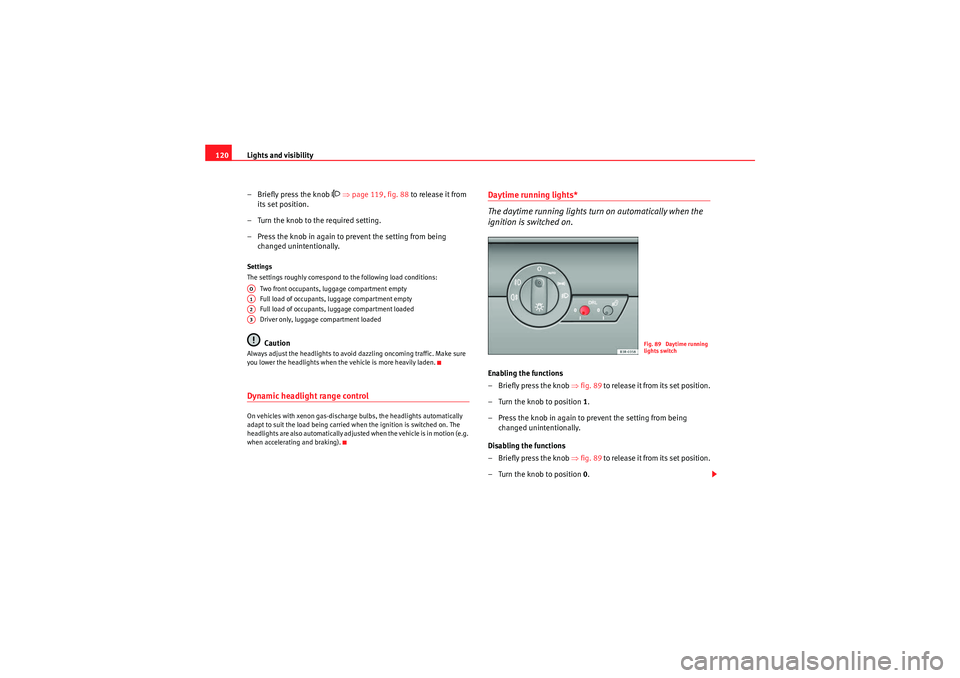
Lights and visibility
120
– Briefly press the knob
⇒ page 119, fig. 88 to release it from
its set position.
– Turn the knob to the required setting.
– Press the knob in again to prevent the setting from being changed unintentionally.
Settings
The settings roughly correspond to the following load conditions:
Two front occupants, luggage compartment empty
Full load of occupants, luggage compartment empty
Full load of occupants, luggage compartment loaded
Driver only, luggage compartment loaded
Caution
Always adjust the headlights to avoid dazzling oncoming traffic. Make sure
you lower the headlights when the vehicle is more heavily laden.Dynamic headlight range controlOn vehicles with xenon gas-discharge bulbs, the headlights automatically
adapt to suit the load being carried when the ignition is switched on. The
headlights are also automatically adjusted when the vehicle is in motion (e.g.
when accelerating and braking).
Daytime running lights*
The daytime running lights turn on automatically when the
ignition is switched on.Enabling the functions
– Briefly press the knob ⇒fig. 89 to release it from its set position.
– Turn the knob to position 1.
– Press the knob in again to prevent the setting from being changed unintentionally.
Disabling the functions
– Briefly press the knob ⇒fig. 89 to release it from its set position.
– Turn the knob to position 0.
AOA1A2A3
Fig. 89 Daytime running
lights switch
Exeo_EN.book Seite 120 Freitag, 28. August 2009 10:14 10
Page 123 of 310
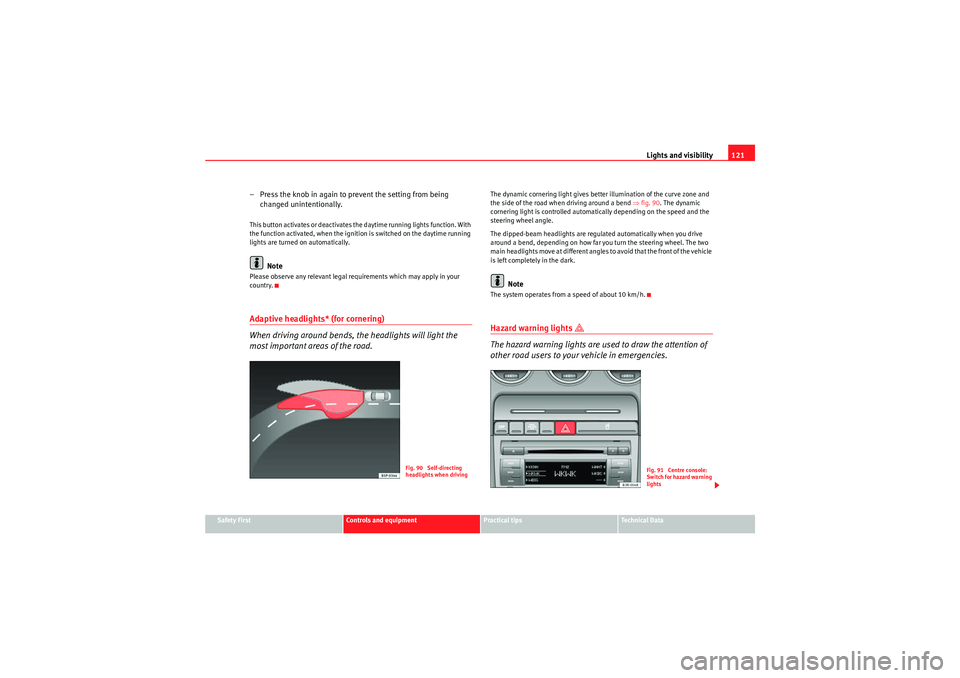
Lights and visibility121
Safety First
Controls and equipment
Practical tips
Technical Data
– Press the knob in again to prevent the setting from being
changed unintentionally.This button activates or deactivates the daytime running lights function. With
the function activated, when the ignition is switched on the daytime running
lights are turned on automatically.
Note
Please observe any relevant legal requirements which may apply in your
country.Adaptive headlights* (for cornering)
When driving around bends, the headlights will light the
most important areas of the road.
The dynamic cornering light gives better illumination of the curve zone and
the side of the road when driving around a bend ⇒fig. 90 . The dynamic
cornering light is controlled automatically depending on the speed and the
steering wheel angle.
The dipped-beam headlights are regulated automatically when you drive
around a bend, depending on how far you turn the steering wheel. The two
main headlights move at different angles to avoid that the front of the vehicle
is left completely in the dark.
Note
The system operates from a speed of about 10 km/h.Hazard warning lights
The hazard warning lights are used to draw the attention of
other road users to your vehicle in emergencies.
Fig. 90 Self-directing
headlights when driving
Fig. 91 Centre console:
Switch for hazard warning
lights
Exeo_EN.book Seite 121 Freitag, 28. August 2009 10:14 10
Page 124 of 310
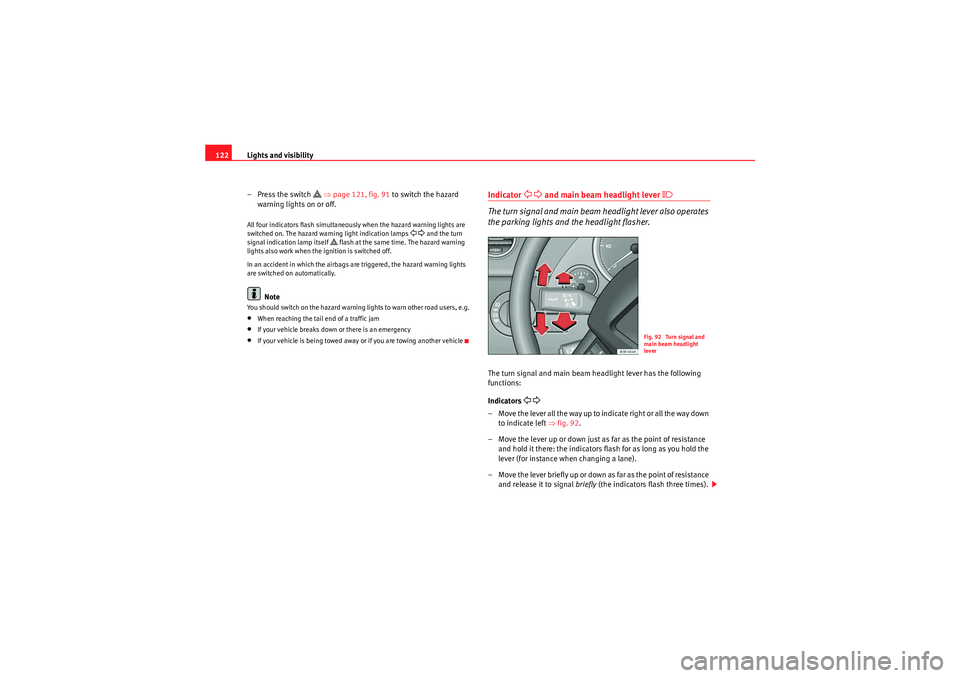
Lights and visibility
122
–Press the switch
⇒ page 121, fig. 91 to switch the hazard
warning lights on or off.
All four indicators flash simultaneously when the hazard warning lights are
switched on. The hazard warning light indication lamps
and the turn
signal indication lamp itself
flash at the same time. The hazard warning
lights also work when the ignition is switched off.
In an accident in which the airbags are triggered, the hazard warning lights
are switched on automatically.
Note
You should switch on the hazard warning lights to warn other road users, e.g.•When reaching the tail end of a traffic jam•If your vehicle breaks down or there is an emergency•If your vehicle is being towed away or if you are towing another vehicle
Indicator
and main beam headlight lever
The turn signal and main beam headlight lever also operates
the parking lights and the headlight flasher.The turn signal and main beam headlight lever has the following
functions:
Indicators
– Move the lever all the way up to indicate right or all the way down to indicate left ⇒fig. 92 .
– Move the lever up or down just as far as the point of resistance and hold it there: the indicators flash for as long as you hold the
lever (for instance when changing a lane).
– Move the lever briefly up or down as far as the point of resistance and release it to signal briefly (the indicators flash three times).
Fig. 92 Turn signal and
main beam headlight
lever
Exeo_EN.book Seite 122 Freitag, 28. August 2009 10:14 10
Page 125 of 310
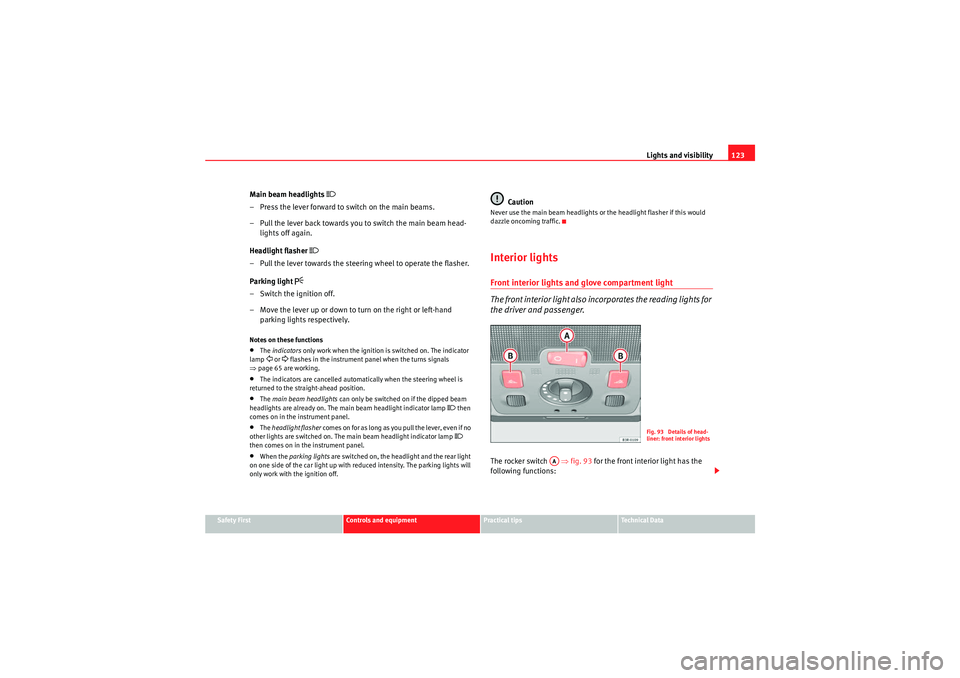
Lights and visibility123
Safety First
Controls and equipment
Practical tips
Technical Data
Main beam headlights
– Press the lever forward to switch on the main beams.
– Pull the lever back towards you to switch the main beam head-
lights off again.
Headlight flasher
– Pull the lever towards the steering wheel to operate the flasher.
Parking light
– Switch the ignition off.
– Move the lever up or down to turn on the right or left-hand
parking lights respectively.Notes on these functions•The indicators only work when the ignition is switched on. The indicator
lamp or flashes in the instrument panel when the turns signals
⇒ page 65 are working.
•The indicators are cancelled automatically when the steering wheel is
returned to the straight-ahead position.•The main beam headlights can only be switched on if the dipped beam
headlights are already on. The main beam headlight indicator lamp
then
comes on in the instrument panel.
•The headlight flasher co m es on for as lo ng as yo u pull th e le ve r, e ve n if no
other lights are switched on. The main beam headlight indicator lamp
then comes on in the instrument panel.
•When the parking lights are switched on, the headlight and the rear light
on one side of the car light up with re duced intensity. The parking lights will
only work with the ignition off.
Caution
Never use the main beam headlights or the headlight flasher if this would
dazzle oncoming traffic.Interior lightsFront interior lights and glove compartment light
The front interior light also incorporates the reading lights for
the driver and passenger.The rocker switch ⇒fig. 93 for the front interior light has the
following functions:
Fig. 93 Details of head-
liner: front interior lights
AA
Exeo_EN.book Seite 123 Freitag, 28. August 2009 10:14 10
Page 126 of 310
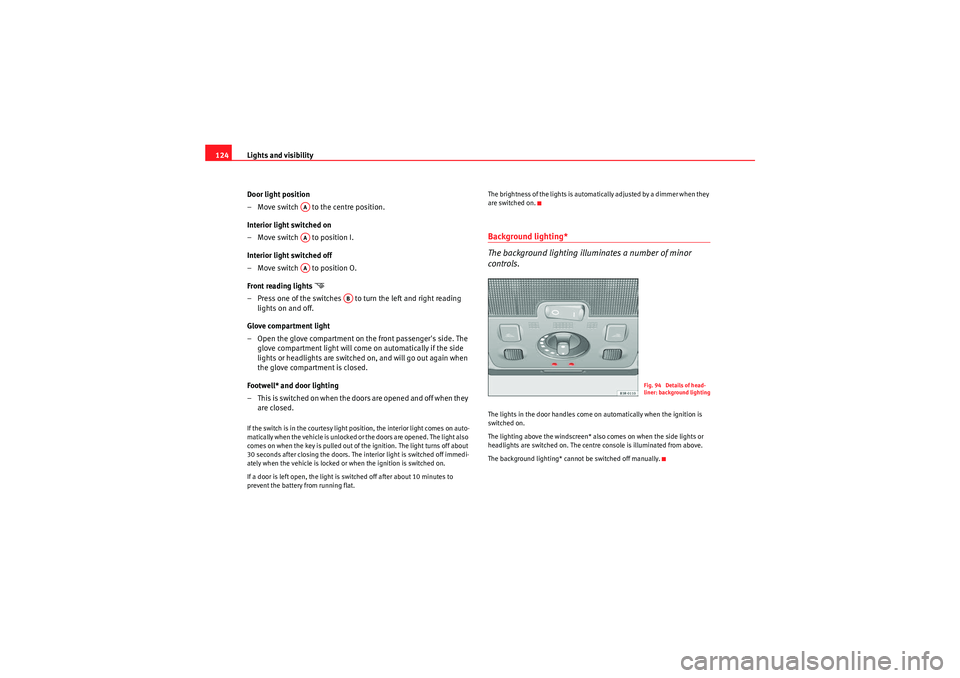
Lights and visibility
124
Door light position
– Move switch to the centre position.
Interior light switched on
– Move switch to position I.
Interior light switched off
– Move switch to position O.
Front reading lights
– Press one of the switches to turn the left and right reading lights on and off.
Glove compartment light
– Open the glove compartment on the front passenger's side. The glove compartment light will come on automatically if the side
lights or headlights are switched on, and will go out again when
the glove compartment is closed.
Footwell* and door lighting
– This is switched on when the doors are opened and off when they are closed.If the switch is in the courtesy light position, the interior light comes on auto-
matically when the vehicle is unlocked or the doors are opened. The light also
comes on when the key is pulled out of the ignition. The light turns off about
30 seconds after closing the doors. The interior light is switched off immedi-
ately when the vehicle is locked or when the ignition is switched on.
If a door is left open, the light is switched off after about 10 minutes to
prevent the battery from running flat. The brightness of the lights is automatically adjusted by a dimmer when they
are switched on.
Background lighting*
The background lighting illuminates a number of minor
controls.The lights in the door handles come on automatically when the ignition is
switched on.
The lighting above the windscreen* also comes on when the side lights or
headlights are switched on. The centre console is illuminated from above.
The background lighting* cannot be switched off manually.
AAAAAA
AB
Fig. 94 Details of head-
liner: background lighting
Exeo_EN.book Seite 124 Freitag, 28. August 2009 10:14 10
Page 127 of 310
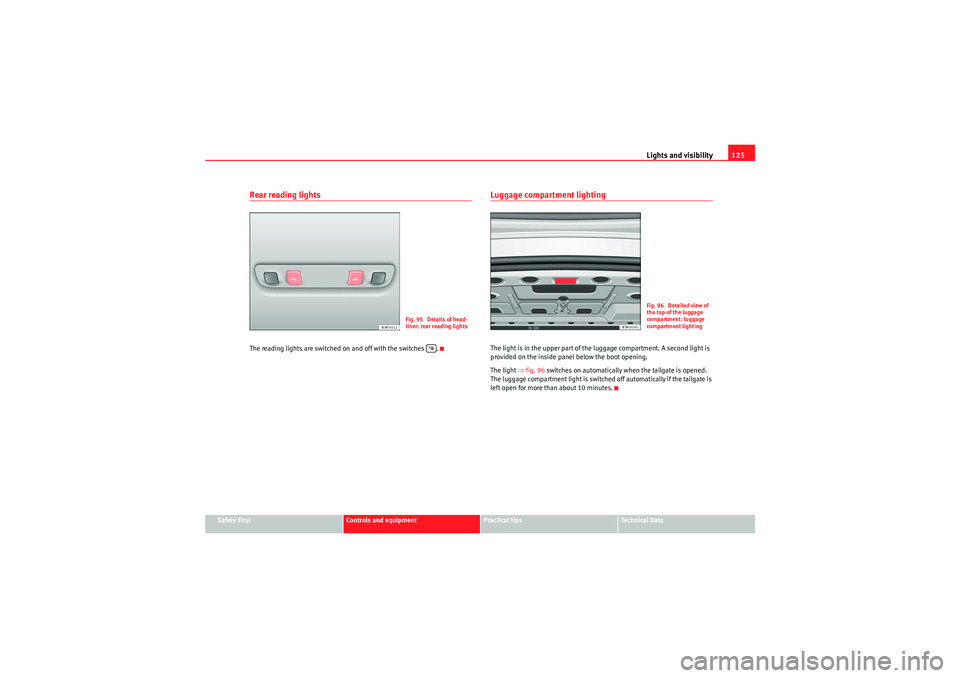
Lights and visibility125
Safety First
Controls and equipment
Practical tips
Technical Data
Rear reading lightsThe reading lights are switched on and off with the switches .
Luggage compartment lightingThe light is in the upper part of the luggage compartment. A second light is
provided on the inside panel below the boot opening.
The light ⇒fig. 96 switches on automatically when the tailgate is opened.
The luggage compartment light is switched off automatically if the tailgate is
left open for more than about 10 minutes.
Fig. 95 Details of head-
liner: rear reading lights
Fig. 96 Detailed view of
the top of the luggage
compartment: luggage
compartment lighting
Exeo_EN.book Seite 125 Freitag, 28. August 2009 10:14 10
Page 128 of 310
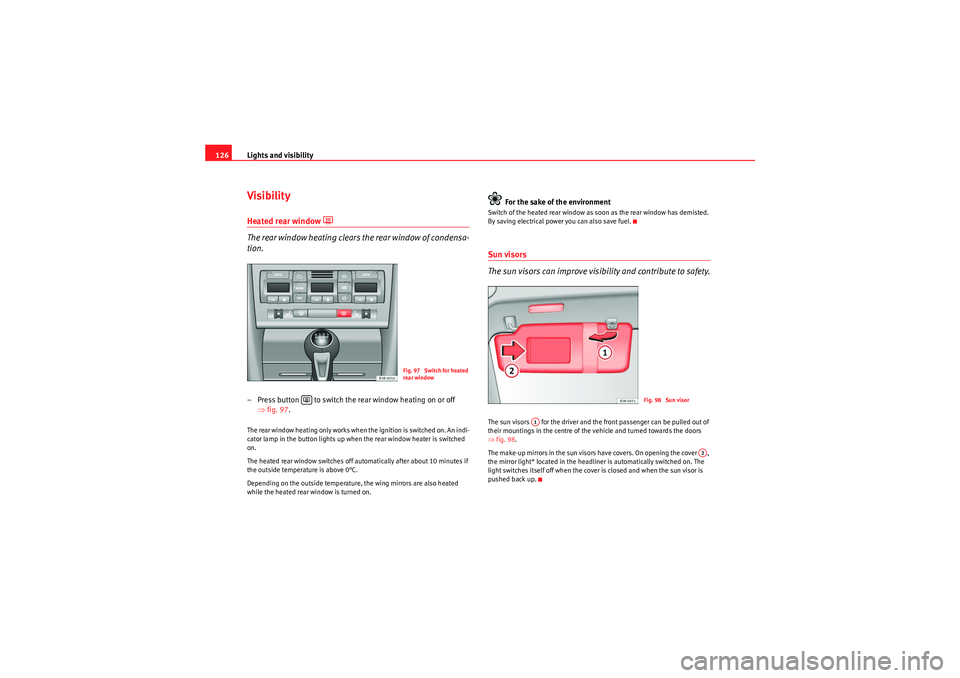
Lights and visibility
126VisibilityHeated rear window
The rear window heating clears the rear window of condensa-
tion.– Press button to switch the rear window heating on or off
⇒fig. 97 .The rear window heating only works when the ignition is switched on. An indi-
cator lamp in the button lights up when the rear window heater is switched
on.
The heated rear window switches off automatically after about 10 minutes if
the outside temperature is above 0°C.
Depending on the outside temperature, the wing mirrors are also heated
while the heated rear window is turned on.
For the sake of the environment
Switch of the heated rear window as soon as the rear window has demisted.
By saving electrical power you can also save fuel.Sun visors
The sun visors can improve visibility and contribute to safety.The sun visors for the driver and the front passenger can be pulled out of
their mountings in the centre of the vehicle and turned towards the doors
⇒ fig. 98.
The make-up mirrors in the sun visors have covers. On opening the cover ,
the mirror light* located in the headliner is automatically switched on. The
light switches itself off when the cover is closed and when the sun visor is
pushed back up.
Fig. 97 Switch for heated
rear window
Fig. 98 Sun visor
A1
A2
Exeo_EN.book Seite 126 Freitag, 28. August 2009 10:14 10
Page 129 of 310
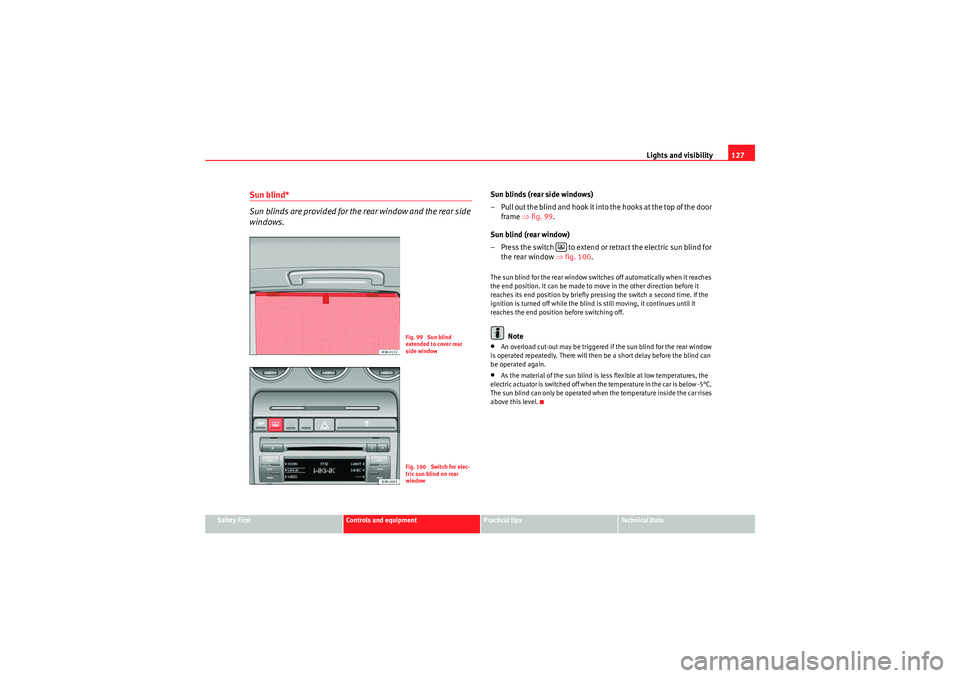
Lights and visibility127
Safety First
Controls and equipment
Practical tips
Technical Data
Sun blind*
Sun blinds are provided for the rear window and the rear side
windows.
Sun blinds (rear side windows)
– Pull out the blind and hook it into the hooks at the top of the door
frame ⇒fig. 99 .
Sun blind (rear window)
– Press the switch to extend or retract the electric sun blind for the rear window ⇒fig. 100 .The sun blind for the rear window switches off automatically when it reaches
the end position. It can be made to move in the other direction before it
reaches its end position by briefly pressing the switch a second time. If the
ignition is turned off while the blind is still moving, it continues until it
reaches the end position before switching off.
Note
•An overload cut-out may be triggered if the sun blind for the rear window
is operated repeatedly. There will then be a short delay before the blind can
be operated again.•As the material of the sun blind is less flexible at low temperatures, the
electric actuator is switched off when the temperature in the car is below -5°C.
The sun blind can only be operated when the temperature inside the car rises
above this level.
Fig. 99 Sun blind
extended to cover rear
side windowFig. 100 Switch for elec-
tric sun blind on rear
window
Exeo_EN.book Seite 127 Freitag, 28. August 2009 10:14 10
Page 130 of 310
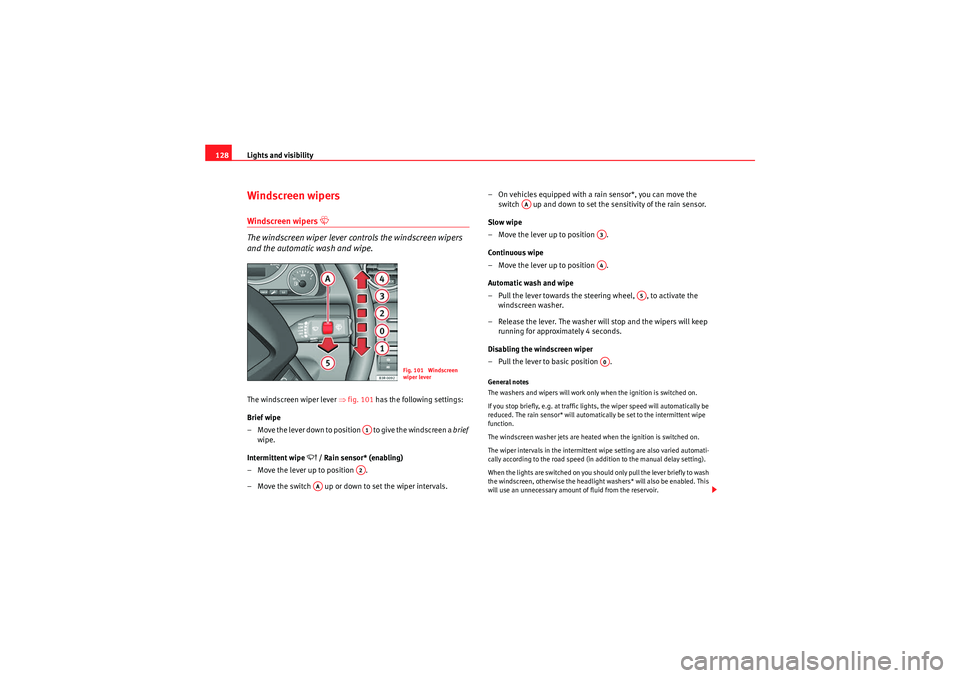
Lights and visibility
128Windscreen wipersWindscreen wipers
The windscreen wiper lever controls the windscreen wipers
and the automatic wash and wipe.The windscreen wiper lever ⇒fig. 101 has the following settings:
Brief wipe
– Move the lever down to position to give the windscreen a brief
wipe.
Intermittent wipe
/ Rain sensor* (enabling)
– Move the lever up to position .
– Move the switch up or down to set the wiper intervals. – On vehicles equipped with a rain sensor*, you can move the
switch up and down to set the sensitivity of the rain sensor.
Slow wipe
– Move the lever up to position .
Continuous wipe
– Move the lever up to position .
Automatic wash and wipe
– Pull the lever towards the steering wheel, , to activate the windscreen washer.
– Release the lever. The washer will stop and the wipers will keep running for approximately 4 seconds.
Disabling the windscreen wiper
– Pull the lever to basic position .
General notes
The washers and wipers will work only when the ignition is switched on.
If you stop briefly, e.g. at traffic lights, the wiper speed will automatically be
reduced. The rain sensor* will automatically be set to the intermittent wipe
function.
The windscreen washer jets are heated when the ignition is switched on.
The wiper intervals in the intermittent wipe setting are also varied automati-
cally according to the road speed (in addition to the manual delay setting).
When the lights are switched on you should only pull the lever briefly to wash
the windscreen, otherwise the headlight washers* will also be enabled. This
will use an unnecessary amount of fluid from the reservoir.
Fig. 101 Windscreen
wiper lever
A1A2
AA
AA
A3A4
A5
A0
Exeo_EN.book Seite 128 Freitag, 28. August 2009 10:14 10